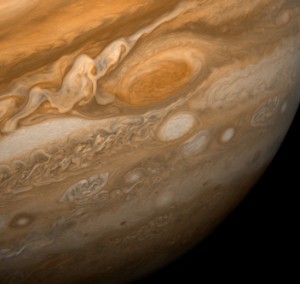Centauri Dreams
Imagining and Planning Interstellar Exploration
The Enduring Legacy of the Voyagers
by Larry Klaes
The Faces from Earth project, run so energetically by Tibor Pacher, is planning its next ‘E.T. Are You Out There?’ campaign, following a successful campaign in May that introduced interstellar concepts to school children in five countries. In this piece, journalist Larry Klaes looks back at the Voyager spacecraft, which will be the subject of the new Faces from Earth campaign. The Voyagers electrified all of us with the discovery of volcanoes on Io and a possible ocean beneath Europa’s ice, and the ensuing stream of images from planets and moons never before seen up close. They also carried golden discs bearing information about their builders. As of this morning (EST), Voyager 1 is 15 hours, 44 minutes, 56 seconds in light-travel time from home, at the edge of the Solar System but, as Larry makes clear, hardly forgotten.
In the first decade of the Space Age, humanity succeeded in sending a handful of robotic space probes to Earth’s two nearest planetary neighbors, Venus and Mars. The voyages of these mechanical vessels, which only took a matter of months, were brief in their visits to these alien worlds. Nevertheless, these new kinds of explorers gave scientists their first knowledge of the true natures of these places after centuries of speculation.
Much farther beyond, where the Sun is eventually reduced in appearance to just a very bright star, is the realm of the outer gas giant worlds. These planets are many times larger than all of the inner terrestrial globes put together and lack solid surfaces in the same sense as our Earth and its celestial brethren. The Jovian planets also keep in their mighty gravitational grips collections of moons and rings of debris that would qualify them as whole solar systems in their own right.
But for humanity in the early days of space exploration, these alien places were very far away and full of unknowns, including whether a fast-moving spacecraft could navigate the natural boundary between the terrestrial and Jovian realms known popularly as the Asteroid Belt without being smashed to pieces by potentially deadly dust and meteoroids. In addition, a spacecraft of that era would take decades to reach all the outer worlds; such vessels were still on the proverbial drawing boards, while most of the actual probes which did reach the nearest worlds in functioning order often did so with a lot of luck and engineering skill.
Beginnings of a Grand Tour
In that same time, when the two main players of the Space Age were preparing to see who could place the first humans on the lunar surface, it was determined that the outer planets would align in such a way in their solar orbits in the late 1970s that they could be reconnoitered by a quartet of nuclear-powered space probes flying past each world in just one decade. The plan and the mission were appropriately named the Grand Tour.
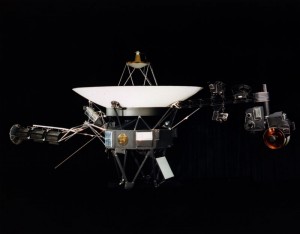
Early on the project was threatened with termination, not by some hazard in space but by budgetary problems on Earth. To stay alive in NASA, the Grand Tour was scaled back to explore just the two nearest gas giants, Jupiter and Saturn. The vessel numbers were reduced from four to two: The remaining probes were christened Mariner 11 and 12, following in the line of American space probes that had opened the way to understanding the inner Solar System. By the time the vessels that remained from the initial outer worlds exploration plan were ready to be launched into the heavens in the late summer of 1977, there were a number of further significant changes to the mission.
Image: The Voyager spacecraft. Voyager’s ‘Golden Record’ can be seen attached to a panel of the spacecraft’s instrument housing. Credit: NASA.
Up front, the twin spacecraft had their names changed from Mariner 11 and 12 to Voyager 1 and 2. This was done both to reflect their expanded designs and goals beyond what the earlier Mariners had accomplished and to make the probes and their missions more exciting to the public. The Voyager team also hoped that, though the craft were still officially meant to explore just Jupiter and Saturn, they would be strong and adaptable enough to complete most of the original Grand Tour plan by reaching Uranus and Neptune just over one decade hence.
Finally, just months before the two Voyagers would leave Cape Canaveral in Florida aboard separate powerful Titan 3E/Centaur rockets, a small group of far-seeing individuals convinced NASA to place a sampling of sights and sounds of our world and our species engraved onto two golden records which were subsequently attached to the sides of the Voyagers. These discs would accompany the probes past the outer worlds into the wider realm of the Milky Way galaxy. These artifacts would serve as a long-lasting record and tribute to the beings who built and launched these early interstellar wanderers and as a greeting for either their distant children or other intelligences that may move among the stars.
Exploring the Gas Giants
With their missions spanning the second decade of the Space Age, the two Voyagers truly revolutionized our understanding of the outer Solar System, in spite of the fact that they were not the first vessels from Earth to explore that region of our celestial neighborhood. That honor went to Pioneer 10 and 11, which flew past Jupiter in 1973 and 1974, respectively, with Pioneer 11 going on to flyby Saturn in 1979. The Pioneer probes then headed off into interstellar space carrying golden plaques engraved with basic information about humans, our Solar System, and our place in the galaxy. Nevertheless, the improved technologies aboard the Voyagers allowed scientists to surpass what was seen and found at and about those enormous globes by either the Pioneers or Earth-bound astronomers of the era.
At their first destination, Jupiter, the Voyagers revealed the incredibly complex patterns of the planet’s cloud patterns, including the Great Red Spot, which was confirmed to be a hurricane system three times the size of Earth that has been churning in the Jovian atmosphere for at least four centuries. Amazing as this was, what captured even more attention from the scientists, media, and public alike were the four large Galilean moons that circled Jupiter, collectively named after the Italian astronomer who discovered them in 1610. These moons were truly worlds in their own right and not the relatively sedate places initially thought to be.
Image: This dramatic view of Jupiter’s Great Red Spot and its surroundings was obtained by Voyager 1 on Feb. 25, 1979, when the spacecraft was 9.2 million kilometers from Jupiter. Cloud details as small as 160 kilometers across can be seen here. Credit: NASA Planetary Photojournal.
The innermost of the Galilean moons, named Io, turned out to have highly active volcanoes spewing molten sulfur all over its surface and far into space. Alien volcanoes had been seen before, on the planet Mars, but Io’s were anything but extinct, to say nothing of being almost completely unexpected before the Voyagers came on the scene in 1979. The next moon nearest to Io, called Europa, was a contrast: The moon’s surface was icy and smooth, populated by long dark lines across its face, with only a few impact craters large enough to be visible to Voyagers’ cameras. But underneath Europa’s covering of ice appeared to be a different story: A global ocean of briny liquid water perhaps sixty miles deep with twice the volume of all the water on Earth! Though certainly not visible to the instruments of its mechanical discoverers, serious speculations on the possibility for living creatures and what forms they might take in the distant waters of Europa wasted little time in appearing.
Thanks to the Voyagers, worlds that were once hardly even considered as abodes of geological activity and life were now seen as even better prospects for living organisms than the traditional worlds in those categories. Voyagers’ discoveries at Jupiter, perhaps more than any other place the probes would fly past on their journeys out of the Solar System, truly changed humanity’s perspectives on the alien realms inhabiting the outer reaches of our celestial neighborhood. Witnessing the truly dynamic nature of our Solar System through the Voyagers also enriched and expanded our thinking about worlds and beings around other suns, made all the more plausible by the discoveries of extrasolar planets in the years since the primary Voyager missions, of which most thus far appear to be similar to Jovian worlds.
Introducing Ourselves to the Cosmos
Thirty-three years after leaving Earth and twenty-one years after Voyager 2 had flown past the last of the gas giant planets, Neptune, both Voyagers continue to function and return priceless data on regions of the outer Solar System where no human-made spacecraft has ever been before. This area, known as the heliosphere, is considered part of the cosmic boundary between our Solar System and where true interstellar space lies. Perhaps before they expire around 2025, one or maybe both of the Voyagers will last long enough to perform one more scientific mark by revealing the constituents of deep space beyond the influence of our Sun.
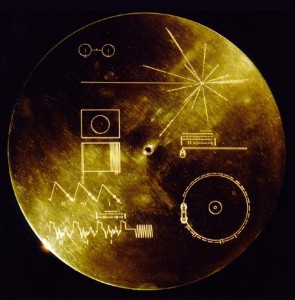
The very fact that the Voyagers would be propelled into the Milky Way galaxy by their interactions with the giant planets of the outer Solar System is what inspired the late Cornell astronomer and science popularizer Carl Sagan and others to create what has become known as the Voyager Interstellar Records. While he and others knew the odds of the Voyagers ever being found by other intelligences were small, the fact that the probes would be only our third and fourth artifacts sent to the stars compelled Sagan and his companions to utilize this opportunity to preserve something of ourselves where it could last far longer than anywhere on Earth, perhaps one billion years or more.
Image: The Voyager ‘Golden Record,’ containing the thoughts, images and sounds of Earth. Credit: NASA.
Most importantly, while the Voyagers were built and launched by the United States of America, the golden records were designed to represent as much of our whole human species and the rest of life on Earth as possible in images, words, sounds, and music. Scanning through the contents of the records (which can be done from this Web site: http://goldenrecord.org/) one gets a definite sense of our being one species on just one world among hundreds of billions of stars in a vast Universe composed of billions of galaxies. To quote Carl Sagan in the Epilogue of the 1978 book on the Voyager Interstellar Record titled Murmurs of Earth: “But one thing would be clear about us: No one sends a message on such a journey, to other worlds and beings, without a positive passion for the future. For all the possible vagaries of the message, they could be sure that we were a species endowed with hope and perseverance, at least a little intelligence, substantial generosity and a palpable zest to make contact with the cosmos.”
Carrying on Voyager’s Work
Faces from Earth is paying tribute to the Voyager missions and the grand concepts embodied by them and all those who made it possible. For in a very real sense the space probes became reality by a collective effort of our civilization, both directly and indirectly. The Voyagers gave us our first real taste, both through their journeys past immense and amazing alien worlds as never witnessed before and the messages and information they carry in those small golden discs on their sides, of what the Cosmos is really like and how we in turn appear in relation to all that vastness of space and time.
Faces from Earth is keeping alive those representations and messages for the current and future generations of humanity, for we are even now becoming Citizens of the Galaxy, no longer confined to the savannahs or villages or even this single planet. While we are still very much the biological creatures of our distant ancestors, we now have an awareness and abilities they never dreamed of. We must mature into the species we are moving towards, one which embodies and embraces new worlds and new ways of life scarcely imagined in the past or even now. Faces from Earth will work together with all those who share the dream of being part of a humanity achieving its full potential among the stars.
For more on the ongoing Voyager missions, try these sites:
NASA/JPL Voyager Web site:
Voyager Interstellar Record information and links (see External Links at end of main page):
http://en.wikipedia.org/wiki/Voyager_Golden_Record
Where are the Voyagers right now?
http://www.heavens-above.com/solar-escape.asp

Time Travel: Ways Around Paradox
Time travel holds such perennial fascination that even though its relationship with interstellar issues is slim, I can’t resist reporting on new ideas about it. John Cramer’s time experiments seem stuck in limbo, but now we have new work from Seth Lloyd (MIT) and colleagues about one way out of the paradoxes time travel seemingly creates. The ‘grandfather paradox,’ returning to the past to kill your own grandfather and thus causing your future self not to exist, seems inevitable if we grant the existence of what are called ‘closed timelike curves’ (CTCs), the paths through spacetime that would let a time traveler interact with his or her self in the past.
Ways Around Paradox
Lloyd’s team gets past that problem by describing a particular version of closed timelike curves formed with what is called ‘post-selection.’ The idea is to describe these CTCs in terms of quantum mechanics, starting with the assumption that time travel is a communications channel from the future to the past. Is there, then, a quantum communication channel to the past? The researchers consider quantum teleportation, in which a quantum measurement combined with classical communication lets quantum states be transported between sender and receiver.
The paper then applies quantum teleportation to timelike curves with postselection (P-CTCs):
We show that if quantum teleportation is combined with post-selection, then the result is a quantum channel to the past. The entanglement occurs between the forward- and backward-going parts of the curve, and post-selection replaces the quantum measurement and obviates the need for classical communication, allowing time travel to take place. The resulting theory allows a description both of the quantum mechanics of general relativistic closed timelike curves, and of Wheeler-like quantum time travel in ordinary spacetime.
As best I can untangle this (and we’ll deal with Wheeler in a moment), the post-selection idea means that time travel paradoxes are ruled out. Try to perform the event causing the paradox and something will happen to make the action fail. Moreover, although this theory of post-selection in timelike curves was created to deal with quantum mechanics in CTCs following the principles of general relativity, the authors think it extends to other contexts. Quantum theory that allows entanglement, in other words, seems to allow time travel even when no spacetime closed timelike curve exists.
Tunneling Through Time
Lloyd’s team says this quantum time travel can be thought of as ‘a kind of quantum tunneling backwards in time, which can take place even in the absence of a classical path from future to past.’ That’s a helpful thought, given that the extreme distortions of spacetime required by more traditional time travel thinking in a relativistic context are all but impossible to create.
Interestingly, there already exists a growing literature on entanglement and projection in the development of timelike curves, all described briefly in this paper. But the authors are particularly careful to note John Wheeler’s ideas impinging on quantum time travel, ideas that Richard Feynman described in his Nobel Prize lecture. This is worth repeating:
‘I received a telephone call one day at the graduate college at Princeton from Professor Wheeler, in which he said, “Feynman, I know why all electrons have the same charge and the same mass.”
“Why?”
“Because, they are all the same electron!”
And, then he explained on the telephone, “Suppose that the world lines which we were ordinarily considering before in time and space – instead of only going up in time were a tremendous knot, and then, when we cut through the knot, by the plane corresponding to a fixed time, we would see many, many world lines and that would represent many electrons, except for one thing. If in one section this is an ordinary electron world line, in the section in which it reversed itself and is coming back from the future we have the wrong sign to the proper time – to the proper four velocities – and that’s equivalent to changing the sign of the charge, and, therefore, that part of a path would act like a positron.”‘
And now we’re really in Wonderland. Post-selection accepts only particular results, meaning that the only states that can be teleported via quantum entanglement are those that are consistent with the world we know. Time travel in this guise is necessarily consistent with our reality and forbids any actions that would create paradoxes. The authors put it this way: “…although any quantum theory of time travel quantum mechanics is likely to yield strange and counter-intuitive results, P-CTCs appear to be less pathological. They are based on a different self-consistent condition that states that self-contradictory events do not happen…”
Ratcheting Up Improbabilities
In an article on this work in Science News, Laura Sanders takes note of the fact that ruling out paradoxes means that unlikely events may happen with greater frequency:
“If you make a slight change in the initial conditions, the paradoxical situation won’t happen. That looks like a good thing, but what it means is that if you’re very near the paradoxical condition, then slight differences will be extremely amplified,” says Charles Bennett of IBM’s Watson Research Center in Yorktown Heights, N.Y.
For instance, a bullet-maker would be inordinately more likely to produce a defective bullet if that very bullet was going to be used later to kill a time traveler’s grandfather, or the gun would misfire, or “some little quantum fluctuation has to whisk the bullet away at the last moment,” Lloyd says. In this version of time travel, the grandfather, he says, is “a tough guy to kill.”
So we have no paradoxes but we seem to be distorting probability, a very strange result but maybe a bit less strange than the paradoxes we’ve avoided. Time travel makes for eerily seductive fiction — who would not wonder about traveling into the past to see loved ones again, or to remedy some unintentional wrong — and judging from the number of emails I received pointing me to this paper, the idea is as compelling now as it has ever been. I hadn’t realized how far back time travel has resonated in history, but the paper notes an account in the Hindu epic called the Mahabarata in which King Revaita visits the Brahma’s palace, stays for only a few days, and returns to Earth only to find that many eons have passed in his absence.
This is more or less the idea behind the creaky science fiction story “Out Around Rigel” (Astounding Stories, December 1931), in which Robert H. Wilson imagines the first journey to another star and uses the event as a way to teach Einsteinian special relativity (the first time this was done in science fiction, to my knowledge). The crew returns to find a thousand years have passed during their six-month journey. But this is a time travel account from the standpoint of relativistic spacetime. Quantum mechanics, in this paper’s estimate, might give us options other than that one-way ticket to the future.
How post-selection would work in quantum mechanics has yet to be determined, but the authors discuss the possibility of testing their theory experimentally by using quantum teleportation. Can people ever hope to take a journey into their own past with a self-consistent, non-paradoxical outcome? Science fiction writers will want to mull over the findings of this thorny, mind-bending paper and especially note the extensive literature treating entanglement and projection in the creation of closed timelike curves.
The paper is Lloyd et al., “The quantum mechanics of time travel through post-selected teleportation,” available as a preprint. Be aware as well of Lloyd et al., “Closed timelike curves via post-selection: theory and experimental demonstration” (preprint). This story on Physorg.com also discusses Lloyd’s work and ponders non-linearity in quantum mechanics.

Solar Sailing’s ‘Gossamer Road’
With more attention now being focused on possible missions to an asteroid, we should keep in mind that DLR, the German Aerospace Center, has been looking into an asteroid mission via solar sail for some time now. One 2006 paper from DLR’s Institute of Space Simulation pondered a 70-meter sail for use in a projected mission to the Near-Earth Object 1996FG3 within ten years of launch. It’s an interesting notion, one that would involve the sail hovering over the NEA hemisphere opposite to the Sun, deploying a lander and return capsule.
DLR has been into serious sail studies for some time now, as the photo below attests. It’s a 1999 shot of the ground deployment of a square solar sail 20 meters to the side. As you can see, this is a square sail made up of four triangular sail segments, an exercise that could readily lead to a sail deployment in space if the European Space Agency opts for funding such a mission. Just what ESA has in mind for such technology was the subject of a presentation at the just concluded Second International Symposium on Solar Sailing in Brooklyn.
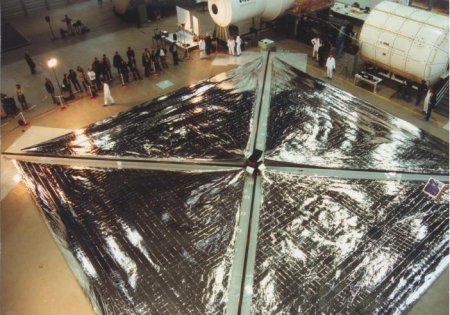
Image: DLR’s deployed solar sail, seen at the Center’s facility in Cologne. Credit: DLR.
I’m looking at the paper on “The 3-Step DLR-ESA Gossamer Road to Solar Sailing,” available in the proceedings of the conference, and enjoying the ‘gossamer road’ metaphor that is so reminiscent of the fabled Silk Road, that network of trade routes that took its name from the Chinese silk trade and reached across Asia to the Mediterannean, Europe and north Africa. Maybe the ‘gossamer road’ is an indicator of enthusiasm at DLR and ESA for renewing sail work, for late last year the two agreed on the road map to solar sailing presented here.
Three consecutive steps define the roadmap:
- Gossamer-1: A 5-meter square solar sail launched as a deployment demonstrator to a 320 kilometer Earth orbit. Documentation of the deployment is to be handled by two onboard cameras (which inevitably calls up the images of the IKAROS sail deployment, similarly tracked). This demonstrator mission would be launched in 2013.
- Gossamer-2: A 20-meter square sail launched to a 500 kilometer Earth orbit. Here the idea is to test orbit and attitude control of a sail built out of thinner materials than the 7.5 µm Kapton used in Gossamer-1. Launch in 2014.
- Gossamer-3: A 50m x 50m solar sail launched to a 10,000 kilometer Earth orbit, with testing of orbit and attitude control and, as with the earlier missions, documentation by onboard cameras. An acceleration > 0.1 mm/s2 is sufficient for the sailcraft to leave the Earth’s gravitational field after a period of about 100 days.
As you see, the gossamer missions build into growing layers of complexity and, because of limited budgets and a tight time schedule, tap the technologies and materials already developed in earlier DLR and ESA sail work. The paper notes that DLR has already done extensive work not only on sail materials but on the boom technology that supports the sail.
Also supporting the Gossamer project is a Light Pressure Measurement Facility (LPMF) set up by the DLR Institute for Space Systems in Bremen and Berlin. This is a key issue, because the reflectivity of the sail materials determines the efficiency of the propulsion achieved, and a variety of processes during a mission can cause that reflectivity to degrade. DLR is also setting up a Complex Irradiation Facility, now being commissioned, to examine the effects of the solar wind and electromagnetic radiation on sail materials. The trick here is to extrapolate from short-period degradation caused by high intensity bombardment in the facility to the longer, slower processes that a sail will experience in the space environment.
It’s interesting to see that so much recent sail technology has revolved around CubeSats, miniaturized satellites weighing no more than one kilogram that typically work with off-the-shelf electronics. CubeSats were developed as a way for universities to become involved in space exploration, but their small size and inexpensive components make them ideal for experimentation of all kinds. These ‘nano-satellites’ play a role in the NanoSail-D and the Planetary Society’s Lightsail-1 projects as well as DLR’s Gossamer program, allowing early risks to be spread over a number of low cost missions. It’s satisfying to think that IKAROS will soon be joined by other experiments shaking out a future workhorse propulsion system.
The asteroid mission referenced above is discussed in Dachwald et al., “Multiple rendezvous and sample return missions to near-Earth objects using solar sailcraft,” Acta Astronautica 59 (2006), pp. 768-776.

Sasselov: Planets ‘Like Earth’ in Kepler Data
Dimitar Sasselov, a co-investigator on the Kepler mission, said in a TED Talk just posted that Kepler had uncovered numerous terrestrial planet candidates in its early data. Have a look at the video below (around the 8-minute mark). “Small planets dominate the picture,” says Sasselov, showing a chart of planet candidates. A great deal of work has to go into confirming these results, but Sasselov goes on to say “The statistical result is loud and clear, and the statistical result is that planets like our own Earth are out there. Our Milky Way galaxy is rich in these kinds of planets.” How many will be confirmed, and how many shown to be habitable? Much work ahead.

The Solar Sail in Context
The final day of the Second International Symposium on Solar Sailing (ISSS 2010) kicks off this morning with Roman Kezerashvili (City University of New York) discussing solar sail missions as a way of testing fundamental physics. Last year in Aosta I listened with fascination as Kezerashvili discussed close solar passes (‘Sundiver’ missions) that could approach as close as 0.05 to 0.1 AU to the Sun, depending on the development of materials technology. The remarkable feature of his talk, though, was the consideration of General Relativity’s effects in such close proximity to the Sun, which could create huge navigation issues.
The ‘Sundiver’ as an Exercise in Physics
Fail to account precisely for spacetime curvature and frame dragging in this environment and such a mission could find itself with a million-kilometer deflection enroute to its target. Even more exotically, time slows in close proximity to the Sun due to relativistic effects, so that the observer on Earth measures about 31 more seconds per year than the observer at 0.01 AU. It will be interesting to see how Kezerashvili follows up his earlier work with colleague Justin Vázquez-Poritz in Physics Letters B on these issues. Today’s talk, based on a paper with Vázquez-Poritz, looks at the Poynting-Robertson effect on solar sail trajectories, and is available in the proceedings.
The effect now partially named after him was first examined by John Henry Poynting in 1904 and later analyzed as an effect of special relativity by Howard Robertson. It has been analyzed in terms of drag on dust grains in the Solar System, which are found to spiral inward as the result of the tangential component of the Sun’s radiation pressure. In solar sail terms, this drag force can influence long-range missions, for the fraction of the Sun’s radiation absorbed by the sail will produce a drag force sufficient to slow the orbital speed of a sail in a solar orbit, and to decrease the cruising velocity and heliocentric distance of a sail on an escape trajectory.
The Poynting-Robertson effect may sound like a small issue, but weigh it against lengthy mission times of the sort we need to contemplate a journey to the heliopause and beyond. A ‘Sundiver’ sail deployed at 0.02 AU would find its cruising velocity decreased by 20 meters per second, a cumulative effect that would decrease its distance from the Sun by more than 20 million kilometers after a 30-year voyage. By exploring these effects, we learn what adjustments to incorporate in future mission planning and are able to examine exotic physical effects in an environment we can produce in no Earth-bound laboratory.
NASA and the Sail
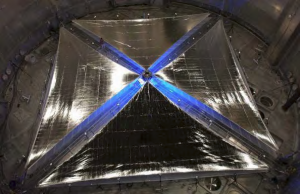
The ISSS 2010 proceedings are stuffed with good material and it will take a while for me to go through all these papers with care. With IKAROS thus far a triumph, where is NASA in current solar sail research? Les Johnson (MSFC) discussed the agency’s progress in the production and testing of two different 20-meter solar sail systems, one developed by ATK Space Systems and the other by L’Garde. Both successfully underwent vacuum testing in NASA Glenn Research Center’s Space Power Facility at Plum Brook Station, Ohio. The ATK sail is shown at left, the L’Garde sail below, as deployed at the Plum Brook Facility (photo credit: NASA GRC).

In his paper in the proceedings, Johnson goes through the software tools, computational methods and optical diagnostic system developed in support of these sails, along with their structural analysis and attitude control systems. He also discussed the development of NanoSail-D, a small sailcraft system developed around a CubeSat. You may recall the failure of the Falcon-1 rocket in 2008 that destroyed the first of these sails, but the second is to be flown this fall in a test of sail deployment and deorbiting using atmospheric drag (the ‘D’ in NanoSail-D stands for ‘De-orbit,’ growing out of NASA Ames’ interest in developing a way of using atmospheric drag to deorbit a small satellite).
So we have the NanoSail-D flight spare scheduled for a fall launch, but what is the future direction of the already extensive NASA work on solar sails? The sad fact is that NASA is not currently funding solar sail technology. Les Johnson goes on to report the upside:
However, NASA is now preparing for a dramatic change in focus toward the development of advanced space technology that will enable new human and robotic exploration of the solar system. Solar sails are a technology that can support this aim, and it is likely that within the next few years NASA will again be aggressively advancing the technology toward mission implementation.
Maybe the success of IKAROS will be a spur to the other major space agencies to increase their interest and funding in sail technologies. Let’s hope so.
Sail/Fusion Hybrids?
And what of deep space concepts? Tau Zero practitioner Pat Galea, whose photos from ISSS 2010 are becoming available on Flickr, today looks at the interesting question of whether there is any synergy between sail and fusion concepts for Project Icarus, the ongoing re-thinking of the Project Daedalus starship design of the 1970s. We’re in the early days of Icarus, with major issues of configuration still unresolved, but Galea uses Daedalus as a starting point and looks to establish boundary conditions, assuming Alpha Centauri A as the probe’s destination.
Icarus has the ambitious goal of reaching speeds between ten and twenty percent of lightspeed, and if at all possible, the designers would like to allow deceleration, either slowing the craft enough to increase encounter time at the target or, in the best case, allowing it to enter an orbit around the star. Remember, Icarus (based on Daedalus) may mass a whopping 50,000 kg after fuel depletion. Galea finds that even assuming an ideal sail, deceleration to orbital capture would involve a sail 944 kilometers in diameter. It would be interesting to compare this number with the specs on a magsail, and I imagine the Icarus team will be running those numbers in the future.
A 944-kilometer sail seems out, but sail technologies can be of use in other aspects of this fusion-centric mission. Galea goes on to ponder using gravitational lensing for communications, noting that solar sail missions to 550 AU and beyond are not all that different from concepts already under discussion for interstellar precursor missions. Claudio Maccone’s FOCAL mission stretches the technology but comes up with realistic methods to reach these distances and deploy tethered-antennae lensing equipment. Maccone has also shown the viability of gravitational lensing for communications at interstellar distances. Thus a mission to 550 AU to establish a communications relay to support Icarus remains a possibility.
Another potential use of sails would be the deployment of sub-probes once Icarus passes through the destination system. The original Daedalus design included up to eighteen sub-probes that would investigate planets in the Barnard’s Star system. Deploying sail-based sub-probes would work if Icarus can decelerate (presumably using its fusion engines) into a stellar orbit. Remaining to be considered is whether solar sails could be of value for these sub-probes in a decelerated flyby, which is the more likely scenario given the huge difficulty in decelerating such a large payload to an orbit in the target system. Galea’s conclusions follow:
The likely large mass of the Icarus craft at launch and arrival in the target system, together with the high interstellar speed renders the use of solar sails implausible for useful acceleration or deceleration of the craft as a whole. However, the two aspects of the mission that could usefully use sails are the deployment of sub-probes in the target system, and the deployment of the gravitational lens communications receiver… Both of these types of craft have similar requirements to solar sails that are traditionally discussed for interplanetary missions.
Finding the Baseline
Figuring out the limits on things is how we proceed with developing new technologies. Not long ago I discussed Ralph McNutt’s recent work at JHU/APL on realistic manned missions to the outer planets. The huge price tag had a number of correspondents baffled. How could we justify the outlay of trillions of dollars on a handful of missions to explore these planets? But nobody was arguing that we should. The point of such studies is to develop the baseline, to tell us where we are today and where we will be in the near future in terms of costs and capabilities. By doing such studies, we learn where we need to improve our methods and revise our thinking.
There is a huge gap between the first successfully deployed sail in space (IKAROS) and the deep space concepts that are kicked around in the literature. But it is only by analyzing those concepts and pushing the limits of our current science that we get a realistic view of the goal. Conferences like ISSS 2010 go from present and near-term all the way to remote future uses of technologies we can’t yet build today. They’re necessary, mind-bending exercises in the art of the possible based on the achievements we’ve already produced. And this year, IKAROS gave every solar sail-minded scientist cause for celebration and renewed effort.
Tomorrow: A look at DLR and ESA’s solar sail work.

A New View of Ontario Lacus
Before I move into today’s story on Titan, I want to mention that those of us who weren’t able to attend the ongoing Second International Symposium on Solar Sailing (ISSS 2010) can take heart in the fact that selected papers from the proceedings have been quickly published online. Conferences vary tremendously in the resources they make available during and after the event, but the ISSS organizers are obviously intent on wide distribution of these interesting talks. Let’s hope those papers not yet included will find their way online in coming days.
TZF’s Pat Galea has posted a number of photos from day one of the event on Flickr, including this shot of JAXA’s Osamu Mori delivering an early talk on the IKAROS mission. Project leader for IKAROS, this man is a solar sail pioneer.
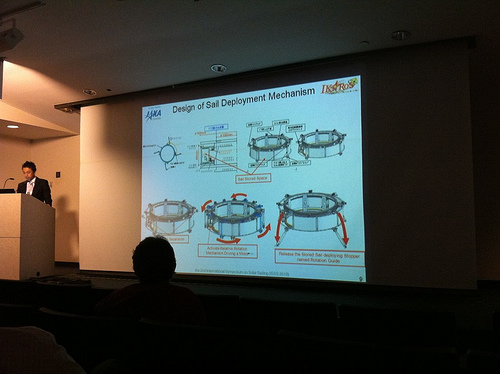
For those of you who’ve asked, the focus of ISSS 2010 is indeed near-term, although several longer-range papers will be presented. With our first operational solar sail only recently launched, this is a time to evaluate where we are and what the next steps will be. The conference is described in the proceedings as being:
…focused on recent advances in solar sailing technologies, near-term solar sailing missions and the physics of solar sailing. Areas of particular interest included dynamics analysis and testing of solar sails, advanced materials and structural concepts of solar sails, hardware and enabling technologies, mission architectures and programs, navigation, control, and modeling.
A Receding Shoreline on Titan
But on to Titan, where the lake levels of Ontario Lacus have continued to spur interest. Last week we learned that this, the largest lake in Titan’s southern hemisphere, is showing clear signs of liquid methane evaporation. It took an examination of four years of Cassini data to show a 1-meter drop in the lake level per year, evidently the result of seasonal evaporation of liquid methane from the mixture of methane, liquid ethane and propane that fill the lake.
The researchers used data from Cassini’s Synthetic Aperture Radar (SAR), studying the intensity of the radar backscatter to derive information about the composition of surface features. They were also able to tap radar altimetry data collected across part of Ontario Lacus from a December 2008 flyby. Oded Aharonson (Caltech) notes the effectiveness of the instruments and the implications of their findings:
“The combination of SAR and altimetry measurements across the transect gave information about the absorptive properties of the liquid, and argues that the liquids are relatively pure hydrocarbons made up of methane and ethane and not a gunky tar.”
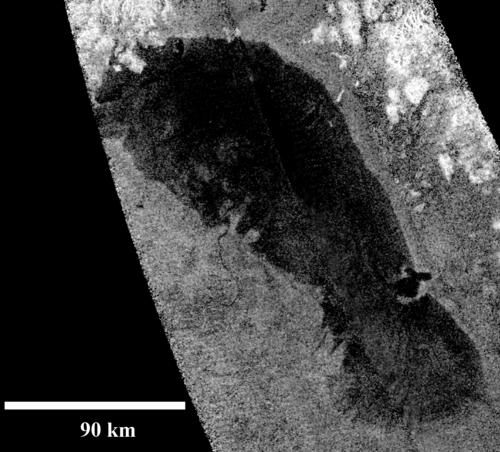
Image: This image of Ontario Lacus, the largest lake on the southern hemisphere of Saturn’s moon Titan, was obtained by NASA’s Cassini spacecraft on Jan. 12, 2010. North is up in this image. Objects appear bright in the radar image when they are tilted toward the spacecraft or have rough surfaces. The lake surface appears dark because it is smooth. The northern shoreline features flooded river valleys and hills as high as 1 kilometer (3,000 feet) in altitude. Credit: NASA/JPL-Caltech.
Cassini’s radar can see through the liquid down to a depth of several meters. The radar will then bounce off the lake floor or, in deeper areas, will be completely absorbed, so that the signature is black. Alexander Hayes, a Caltech graduate student who worked with Aharonson on the project, notes that the lake liquid’s optical properties have been characterized enough to allow the local slope of the lakebed (bathymetry) to be detected. The team was thus able to calculate the slope of the lakebed around the entirety of Ontario Lacus.
The slope turns out to be fairly steep along the lake’s northern boundary as it runs up against a range of mountains, while the lake is at its most shallow and gently sloped along the southern edge, and it is here that sediment is accumulating. Along its eastern shore, the slope of the lake is somewhat steeper. “This is what we are calling the ‘beachhead,'” Hayes says.
The Approach of Autumn
What the researchers have found at Ontario Lacus parallels what Cassini shows about the evaporation of methane from nearby lakes, comparing 2007 data with data from May of 2009. The radar-attenuating liquid decreased or disappeared entirely in these, indicating a reduction of the liquid levels. The same one meter per year loss rate emerges in these results. If you haven’t already seen it, the video tour of Ontario Lacus based on radar data from Cassini’s flybys of Titan is well worth a look.
Cassini’s continued presence in the Saturnian system is paying major dividends. The spacecraft arrived in 2004, when the southern hemisphere of Saturn and its moons was experiencing summer. Now we’re seeing autumn approaching on Titan, a place whose year is the equivalent of about 29 Earth years. As for Ontario Lacus itself, the evaporation now seen from the lake would most likely reverse during winter in the southern hemisphere. It’s breathtaking to consider that we’re dealing with a lake whose surface area (about 15,000 square kilometers) is only slightly smaller than Lake Ontario here on Earth.

